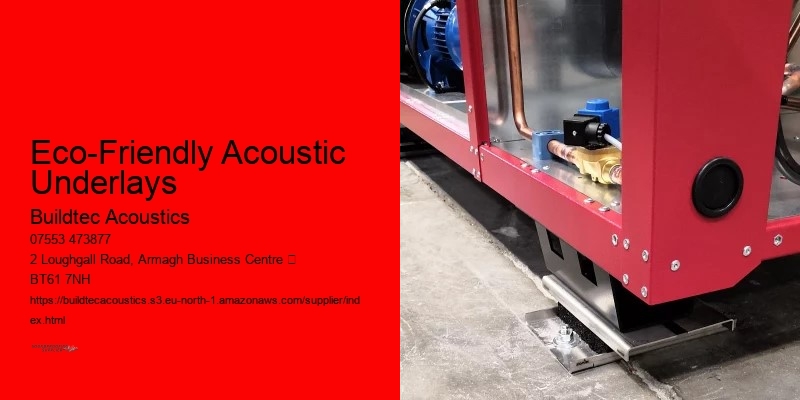

The installation of acoustic underlays is straightforward and suitable for both professionals and do-it-yourself (DIY) enthusiasts. In commercial settings, reducing noise pollution creates a more productive and pleasant work environment, boosting overall efficiency. In commercial settings, reducing noise pollution creates a more productive and pleasant work environment, enhancing overall efficiency. https://en.wikipedia.org/wiki/Soundproofing . Acoustic underlay is an effective solution for managing noise control in both residential and commercial spaces. In commercial environments, reducing noise pollution creates a more productive and pleasant work environment, which enhances overall efficiency.
For instance, Tecsound underlays are often used beneath concrete or screed subfloors to add a layer of soundproofing that is effective against vibration and noise. Soundproofing Material Products from this Soundproofing Supplier are affective acoustic solutions. By reducing both airborne and impact noise, these underlays contribute to creating a peaceful environment, whether in the home, office, or commercial spaces. Most underlays come in sheet or roll form and can be cut to size using simple tools like a utility knife. This allows consumers to achieve their desired aesthetics without sacrificing soundproofing performance.
The compatibility with different floor finishes makes acoustic underlays an essential component in modern flooring design, helping to create a space that is both visually appealing and acoustically comfortable. The compatibility with different floor finishes makes acoustic underlays an essential component of modern flooring design, helping to create a space that is both visually appealing and acoustically comfortable. These underlays not only contribute to noise reduction but also enhance thermal conductivity, supporting efficient heat transfer within the room.
The compatibility with different floor finishes makes acoustic underlays an essential component in modern flooring design, helping to create a space that is both visually appealing and acoustically comfortable. They are particularly effective when used with materials like ceramic tiles or floating floors, providing both sound insulation and comfort underfoot. Buildtec Acoustics offers a wide range of acoustic underlays designed to handle both airborne and impact noise, making them suitable for various flooring applications, including wood flooring, ceramic tiles, and laminate flooring.
Most underlays come in sheets or rolls and can be cut to size with simple tools like a utility knife. They are particularly effective when used with materials like ceramic tiles or floating floors, providing both sound insulation and comfort underfoot.
By selecting the right product for the specific noise control requirement, homeowners and businesses can create a quieter, more comfortable atmosphere. Hard surfaces, such as hardwood and laminate, tend to amplify sounds like footsteps, which can lead to unwanted echo and reverberation. consumer
In summary, acoustic underlays from Buildtec Acoustics provide an effective solution for soundproofing floors, improving room acoustics, and enhancing overall comfort. Acoustic underlays absorb these sounds, contributing to improved room acoustics.
Techniques
Absorption
Sound-absorbing material controls reverberant sound pressure levels within a cavity, enclosure or room. Synthetic absorption materials are porous, referring to open cell foam (acoustic foam, soundproof foam).[3] Fibrous absorption material such as cellulose, mineral wool, fiberglass, sheep's wool, are more commonly used to deaden resonant frequencies within a cavity (wall, floor, or ceiling insulation), serving a dual purpose along with their thermal insulation properties. Both fibrous and porous absorption material are used to create acoustic panels, which absorb sound reflections in a room, improving speech intelligibility.[4][5]
A detailed discussion on the benefits of using soundproofing membranes, covering best practices, materials, and applications.
Posted by Francis McKenna on 2023-04-19
A detailed discussion on soundproofing solutions for home theaters, covering best practices, materials, and applications.
Posted by Francis McKenna on 2023-12-03
A detailed discussion on how to reduce echo and reverberation in large spaces, covering best practices, materials, and applications.
Posted by Francis McKenna on 2023-03-16
A detailed discussion on the benefits of acoustic baffles in large rooms, covering best practices, materials, and applications.
Posted by Francis McKenna on 2023-03-14
A detailed discussion on how soundproofing contributes to sustainable building design, covering best practices, materials, and applications.
Posted by Francis McKenna on 2023-04-10
A detailed discussion on soundproofing for music studios: best practices, covering best practices, materials, and applications.
Posted by Francis McKenna on 2023-03-14
A detailed discussion on effective noise control for residential buildings, covering best practices, materials, and applications.
Posted by Francis McKenna on 2023-03-14
The materials used in acoustic underlays, such as foam, cork, and natural rubber, are highly effective at reducing vibrations and controlling noise. When talking about soundproofing solutions, acoustic underlays are an effective option for reducing noise pollution, improving room acoustics, and creating a quieter and more comfortable living or working environment. In conclusion, acoustic underlays from Buildtec Acoustics offer an effective solution for soundproofing floors, enhancing room acoustics, and improving the overall comfort of a space. By utilizing high-density materials like crumb rubber and cork, acoustic underlays efficiently control noise, reducing its impact on people in adjacent rooms or units. Underlays help isolate vibrations, preventing them from being transmitted through the building structure and reducing their impact on adjacent rooms or units.
Acoustic underlays are useful in many applications, including renovation projects. Installing acoustic underlays beneath carpets in office spaces helps mitigate foot traffic noise and other disturbances, improving room dynamics. Airborne noise, such as music or conversations, can be reduced by selecting underlays with higher sound transmission class ratings. Underlays help isolate vibrations, preventing them from being transmitted through the building structure and reducing the impact on adjacent rooms or units.
Acoustic underlays help absorb these sounds, resulting in better room acoustics. By using high-density materials like crumb rubber and cork, acoustic underlays efficiently control noise, reducing its impact on people in adjacent rooms or units. Whether in a single-family detached home or a semi-detached house, installing acoustic underlay ensures that daily activities do not negatively impact others in the building. Airborne noise includes sounds like conversations, music, and television.
Impact noise occurs from activities such as walking, moving furniture, or using appliances like washing machines, while airborne noise includes sounds like conversations, music, and television. Acoustic underlays are valuable for renovation projects as well. For example, underlays installed beneath medium-density fibreboard (MDF) or gypsum drywall can help absorb vibrations and reduce unwanted sound transmission. For example, Tecsound underlays are commonly used beneath concrete or screed subfloors to provide a layer of soundproofing that is effective against vibration and noise.
This contributes to better communication between occupants by reducing noise interference. Buildtec Acoustics provides underlays with specific properties to address either airborne or impact noise.
Acoustic underlay is a critical solution for effective noise control in residential and commercial environments.
Before installing an acoustic underlay, it is important to ensure that the subfloor-whether concrete, particle board, or cement-is clean, level, and dry.
This allows consumers to achieve their preferred aesthetics without sacrificing soundproofing performance.

Acoustic underlays are compatible with a wide range of flooring materials, including tiles, carpet, and wood. These options support sustainability by reducing reliance on virgin materials and lowering overall pollution. In rooms with underfloor heating, selecting an underlay with low thermal resistance ensures that heat can transfer efficiently without being obstructed by the soundproofing material. Hard surfaces, such as hardwood and laminate, tend to amplify sounds like footsteps, leading to unwanted echo and reverberation. Acoustic underlays are compatible with various flooring materials, including tiles, carpet, and wood. Buildtec Acoustics offers a variety of acoustic underlays to meet different needs, including those designed for underfloor heating systems.
Acoustic underlays made from polyvinyl chloride (PVC) or cork are ideal choices, as they balance both thermal insulation and soundproofing requirements.


Most underlays come in sheet or roll form and can be cut to size with simple tools like a utility knife. The installation of acoustic underlays is straightforward and can be performed by both professionals and do-it-yourself (DIY) enthusiasts. Floating floor systems also benefit from acoustic underlays, which provide an extra layer of soundproofing beneath the flooring material. They are designed to be installed beneath the visible flooring material, meaning that the desired flooring-whether it is elegant hardwood, practical laminate, or cozy carpet-is maintained without alteration. Buildtec Acoustics offers a variety of acoustic underlays to meet different needs, including those designed for underfloor heating systems. Whether in a single-family detached home or a semi-detached house, installing acoustic underlay ensures that daily activities do not negatively impact others in the building.
These options support environmentalism by reducing the need for virgin materials and lowering overall pollution. Acoustic underlays are compatible with a wide variety of flooring materials, including tiles, carpet, and wood. Airborne noise, such as music or conversations, can be reduced by choosing underlays with higher sound transmission class ratings. Most underlays come in sheets or rolls and can be cut to size with simple tools like a utility knife. This process involves transforming sound energy into heat, which then dissipates without causing disturbances.
The use of recycled fibers and materials encourages recycling while reducing the environmental footprint of soundproofing installations. When considering soundproofing solutions, acoustic underlays provide an effective means to reduce noise pollution, improve room acoustics, and create a comfortable environment. Buildtec Acoustics provides underlays made from environmentally friendly materials, such as cork, recycled crumb rubber, and natural wool. Additionally, these materials are low in volatile organic compound (VOC) emissions, contributing to a healthier indoor environment. Most underlays come in sheets or rolls and can be cut to size using simple tools like a utility knife.
Buildtec Acoustics offers a variety of acoustic underlays to meet different needs, including those designed for underfloor heating systems. Some underlays are also certified by Leadership in Energy and Environmental Design (LEED) standards, contributing to sustainable building practices. By utilizing high-density materials like crumb rubber and cork, acoustic underlays offer efficient noise control, reducing the impact of noise on people in adjacent rooms or units. Acoustic underlays function by absorbing and dissipating sound energy, which helps in controlling noise and minimizing its transmission through flooring. This allows consumers to achieve their preferred aesthetics without sacrificing soundproofing performance.
Acoustic underlays are also effective for vibration isolation, particularly in spaces with significant sources of vibration, such as near heating equipment or heavy appliances. In commercial settings, reducing noise pollution creates a more productive and pleasant work environment, boosting overall efficiency.
Acoustic underlays are versatile and can be used in a variety of settings, from residential homes to commercial spaces like offices or retail environments. carpet
These underlays act as a cushion that reduces the transmission of vibrations and sound through the floor.
By reducing both airborne and impact noise, these underlays help create a peaceful environment, whether at home, in the office, or in commercial buildings.